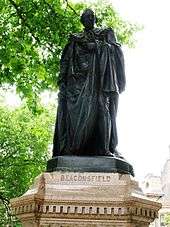Mario Raggi
Mario Raggi (1821–26 November 1907) was an Italian sculptor who settled in England.
Life
Raggi was born at Carrara, Italy where he learnt to sculpt, although much of his reputation was made in England. He studied at the Royal Academy Schools in London where he won several prizes. After further study in Rome and London he established his own studio in London at Cumberland Market. Raggi first exhibited busts at the Royal Academy in 1878, and continued to do so until 1895.
Raggi was given some major commissions; memorials to Benjamin Disraeli at Parliament Square and Gladstone at Albert Square, Manchester. He completed three monumental statues of Queen Victoria for Hong Kong, Toronto and Kimberley in South Africa.[1] A bronze statue by Raggi of Henry Vivian, 1st Baron Swansea wearing a frock coat and gown stands in St. David's Shopping Centre in Swansea.[2]
Raggi is buried at West Norwood Cemetery, where his memorial is a flat slab.
Selected works
| Image | Title / subject | Location and coordinates |
Date | Type | Material | Dimensions | Designation | Wikidata | Notes |
|---|---|---|---|---|---|---|---|---|---|
 More images |
Statue of Benjamin Disraeli | Parliament Square, London | 1883 | Statue on pedestal | Bronze and granite | Grade II | Q18161998 | [3] | |
.jpg) More images |
Henry Hussey Vivian | Swansea | 1886 | Statue on pedestal | Bronze and granite | 4.8m high | [4] | ||
 More images |
Howel Gwyn | Victoria Gardens, Neath | 1889 | Statue on pedestal | Bronze and granite | 5.5m high | [5] | ||
_-_801.jpg) More images |
Statue of Queen Victoria | Victoria Park, Hong Kong | 1896 | Statue on pedestal | Bronze and stone | Q47305137 | [6] | ||
.jpg) More images |
William Ewart Gladstone | Albert Square, Manchester | 1901 | Statue on pedestal | Bronze, granite and sandstone | Grade II | Q26492263 | [7][8] | |
More images |
Queen Victoria | Queen's Park, Toronto | 1903 | Statue on pedestal with bronze reliefs | Bronze and stone | Commissioned 1870, unveiled 1903. Bronze reliefs by J.L. Banks.[1] | |||
_-_005.jpg) More images |
Statue of Sir Thomas Jackson, 1st Baronet | Statue Square, Hong Kong | 1906 | Statue on pedestal | Bronze and stone | Q48802351 |
References
- "Monument to Queen Victoria". Yale Center for British Art. Retrieved 6 August 2020.
- Newman, John; Hughes, Stephen R.; Ward, Anthony (1995). Glamorgan: (Mid Glamorgan, South Glamorgan and West Glamorgan). Penguin Books; University of Wales Press. p. 601. ISBN 978-0-14-071056-4.
- Historic England. "Statue of Benjamin Disraeli, Earl of Beaconsfield (1226370)". National Heritage List for England. Retrieved 5 August 2020.
- "Core Record: Statue of Sir Henry Hussey Vivian". vads. Retrieved 6 August 2020.
- "Core Record: Statue of Howel Gwyn". vads. Retrieved 5 August 2020.
- "Statue of Queen Victoria". Yale Center for British Art. Retrieved 6 August 2020.
- Historic England. "Gladstone statue (1197823)". National Heritage List for England. Retrieved 5 August 2020.
- "Core Record: William Gladstone". vads. Retrieved 5 August 2020.
- Lee, Sidney, ed. (1912). . Dictionary of National Biography (2nd supplement). 3. London: Smith, Elder & Co.
External links
| Wikimedia Commons has media related to Mario Raggi. |
- Paintings by or after Mario Raggi at the Art UK site